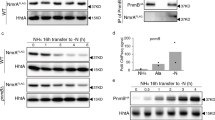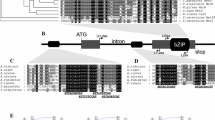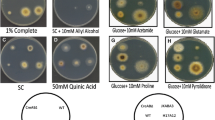Abstract
Previous studies have shown that expression of the gdhA gene, encoding NADP-linked glutamate dehydrogenase (NADP-GDH), in Aspergillus nidulans is regulated by the major nitrogen regulatory protein AreA and its co-activator TamA. We show here that loss of TamA function has a more severe effect on the levels of gdhA expression than loss of AreA function. Using TamA as the bait in a yeast two-hybrid screen, we have identified a second protein that interacts with TamA. Sequencing analysis and functional studies have shown that this protein, designated LeuB, is a transcriptional activator with similar function to the homologous Leu3p of Saccharomyces cerevisiae. Inactivation of leuB revealed that this gene is involved in the regulation of gdhA, and an areA; leuB double mutant was shown to have similar NADP-GDH levels to a tamA single mutant. The requirement for TamA function to promote gdhA expression is likely to be due to its dual interaction with AreA and LeuB.




Similar content being viewed by others
References
Andrianopoulos A, Hynes MJ (1988) Cloning and analysis of the positively acting regulatory gene amdR from Aspergillus nidulans. Mol Cell Biol 8:3532–3541
Andrianopoulos A, Kourambas S, Sharp JA, Davis MA, Hynes MJ (1998) Characterization of the Aspergillus nidulans nmrA gene involved in nitrogen metabolite repression. J Bacteriol 180:1973–1977
Arst HN, MacDonald K (1973) A mutant of Aspergillus nidulans lacking NADP-linked glutamate dehydrogenase. Mol Gen Genet 128:111–141
Arst HN Jr, Brownlee AG, Cousen SA (1982) Nitrogen metabolite repression in Aspergillus nidulans: a farewell to TamA? Curr Genet 6:245–257
Ausubel FM, Brent R, Kingston RE, Moore DD, Smith JA, Seidman JG, Struhl K (1987) Current protocols in molecular biology. Wiley, New York
Avendano A, Deluna A, Olivera H, Valenzuela L, Gonzalez A (1997) GDH3 encodes a glutamate dehydrogenase isozyme, a previously unrecognised route for glutamate biosynthesis in Saccharomyces cerevisiae. J Bacteriol 179:5594–5597
Baichwal VR, Cunningham TS, Gatzek PR, Kohlhaw GB (1983) Leucine biosynthesis in yeast: identification of two genes ( LEU4, LEU5) that affect alpha-isopropylmalate synthase activity and evidence that LEU1 and LEU2 gene expression is controlled by alpha-isopropylmalate and the product of a regulatory gene. Curr Genet 7:369–377
Chen H, Kinsey JA (1994) Sequential gel mobility shift scanning of 5′ upstream sequences of the Neurospora crassa am (GDH) gene. Mol Gen Genet 242:399–403
Chen H, Crabb JW, Kinsey JA (1998) The Neurospora aab-1 gene encodes a CCAAT-binding protein homologous to yeast HAP5. Genetics 148:123–130
Christensen T, Hynes MJ, Davis MA (1998) Role of the regulatory gene areA of Aspergillus oryzae in nitrogen metabolism. Appl Environ Microbiol 64:3232–3237
Clutterbuck AJ (1974) Aspergillus nidulans genetics. In: King RC (ed) Handbook of genetics (vol 1). Plenum Press, New York, pp 447–510
Cove DJ (1966) The induction and repression of nitrate reductase in the fungus Aspergillus nidulans. Biochim Biophys Acta 133:51–56
Dang V-D, Bohn C, Bolotin-Fukuhara M, Daignan-Fournier B (1996) The CCAAT box-binding factor stimulates ammonium assimilation in Saccharomyces cerevisiae, defining a new cross-pathway regulation between nitrogen and carbon metabolisms. J Bacteriol 178:1842–1849
Dantzig AH, Weigmann FL Jr, Nason A (1979) Regulation of glutamate dehydrogenases in nit-2 and am mutants of Neurospora crassa. J Bacteriol 137:1333–1339
Daugherty JR, Rai R, El Berry HM, Cooper TG (1993) Regulatory circuit for responses of nitrogen catabolic gene expression to the GLN3 and DAL80 proteins and nitrogen catabolite repression in Saccharomyces cerevisiae. J Bacteriol 175:64–73
Davis MA, Small AJ, Kourambas S, Hynes MJ (1996) The tamA gene of Aspergillus nidulans contains a putative zinc cluster motif which is not required for gene function. J Bacteriol 178:3406–3409
Ehinger A, Denison SH, May GS (1990) Sequence, organisation and expression of the core histone genes of Aspergillus nidulans. Mol Gen Genet 222:416–424
Fincham JRS (1951) The occurrence of glutamic dehydrogenase in Neurospora and its apparent absence in certain mutant strains. J Gen Microbiol 5:793–806
Forbes E (1959) Use of mitotic segregation for assigning genes to linkage groups in Aspergillus nidulans. Heredity 13:67–80
Friden P, Schimmel P (1987) LEU3 of Saccharomyces cerevisiae encodes a factor for the control of RNA levels of a group of leucine-specific genes. Mol Cell Biol 7:2708–2717
Friden P, Schimmel P (1988) LEU3 of Saccharomyces cerevisiae activates multiple genes for branched-chain amino acid biosynthesis by binding to a common decanucleotide core sequence. Mol Cell Biol 8:2690–2697
Fu Y-H, Marzluf GA (1990 ) nit-2, the major nitrogen regulatory gene of Neurospora crassa, encodes a protein with a putative zinc finger DNA-binding domain. Mol Cell Biol 10:1056–1065
Gietz D, St. Jean A, Woods RA, Schiestl RH (1992) Improved method for high efficiency transformation of intact yeast cells. Nucleic Acids Res 20:1425
Hannon GJ, Demetrick D, Beach D (1993) Isolation of the Rb-related p130 through its interaction with CDK2 and cyclins. Genes Dev 7:2378–2391
Hawkins AR, Gurr SJ, Montague P, Kinghorn JR (1989) Nucleotide sequence and regulation of expression of the Aspergillus nidulans gdhA gene encoding NADP dependent glutamate dehydrogenase. Mol Gen Genet 218:105–111
Hellauer K, Rochon M-H, Turcotte B (1996) A novel DNA binding motif for yeast zinc cluster proteins: the Leu3p and Pdr3p transcriptional activators recognize everted repeats. Mol Cell Biol 16:6096–6102
Hsu Y-P, Schimmel P (1984) Yeast LEU1: repression of mRNA levels by leucine and relationship of 5′-noncoding region to that of LEU2. J Biol Chem 259:3714–3719
Hu Y, Cooper TG, Kohlhaw GB (1995) The Saccharomyces cerevisiae Leu3 protein activates expression of GDH1, a key gene in nitrogen assimilation. Mol Cell Biol 15:52–57
Ito H, Fukuda Y, Murata K, Kimura A (1983) Transformation of intact yeast cells treated with alkali cations. J Bacteriol 153:163–168
Jacobs E, Dubois E, Hennaut C, Wiame J-M (1981) Positive regulatory elements involved in urea amidolyase and urea uptake induction in Saccharomyces cerevisiae. Curr Genet 4:13–18
Kinghorn JR, Pateman JA (1975a) The structural gene for NADP L-glutamate dehydrogenase in Aspergillus nidulans. J Gen Microbiol 86:294–300
Kinghorn JR, Pateman JA (1975b) Studies of partially repressed mutants at the tamA and areA loci in Aspergillus nidulans. Mol Gen Genet 140:137–147
Kudla B, Caddick MX, Langdon T, Martinez-Rossi N, Bennett CF, Sibley S, Davies RW, Arst HN Jr (1990) The regulatory gene areA mediating nitrogen metabolite repression in Aspergillus nidulans. Mutations affecting specificity of gene activation alter a loop residue of a putative zinc finger. EMBO J 9:1355–1364
Lee S, Taylor J (1990) Isolation of DNA from fungal mycelia and single spores, p282–287. In: Innis MA, Gelfand DH, White TJ (eds) PCR protocols: a guide to methods and applications. Academic Press, San Diego
Magasanik B (1992) Regulation of nitrogen utilization. In: Jones EW, Pringle JR, Broach JR (eds) The molecular and cellular biology of the yeast Saccharomyces: gene expression. Cold Spring Harbor Laboratory Press, Cold Spring Harbor, N.Y., pp 283–317
Mamane Y, Hellauer K, Rochon M-H, Turcotte B (1998) A linker region of the yeast zinc cluster protein Leu3p specifies binding to everted repeat DNA. J Biol Chem 273:18556–18561
Minehart PL, Magasanik B (1991) Sequence and expression of GLN3, a positive nitrogen regulatory gene of Saccharomyces cerevisiae encoding a protein with a putative zinc finger DNA-binding domain. Mol Cell Biol 11:6216–6228
Monahan BJ, Fraser JA, Hynes MJ, Davis MA (2002) Isolation and characterisation of two ammonium permease genes, meaA and mepA, from Aspergillus nidulans. Euk Cell 1:85–94
Morozov I Y, Martinez MG, Jones MG, Caddick MX (2000) A defined sequence within the 3′UTR of the areA transcript is sufficient to mediate nitrogen metabolite signalling via accelerated deadenylation. Mol Microbiol 37:1248–1257
Oakley CE, Weil CF, Kretz PL, Oakley BR (1987) Cloning of the riboB locus of Aspergillus nidulans. Gene 53:293–298
Papagiannopoulos P, Andraianopoulos A, Sharp JA, Davis MA, Hynes MJ (1996) The hapC gene of Aspergillus nidulans is involved in the expression of CCAAT-containing promoters. Mol Gen Genet 251:412–421
Platt A, Langdon T, Arst HN Jr, Kirk D, Tollervey D, Mates Sanchez JM, Caddick MX (1996) Nitrogen metabolite signalling involves the C-terminus and the GATA domain of the Aspergillus transcription factor AREA and the 3′ untranslated region of its mRNA. EMBO J 15:2791–2801
Reigo L, Avendano A, DeLuna A, Rodriguez E, Gonzalez A (20002) GDH1 expression is regulated by GLN3, GCN4 and HAP4 under respiratory growth. Biochem Biophys Res Comm 293:79–85
Robzyk K, Kassir Y (1992) A simple and highly efficient procedure for rescuing autonomous plasmids from yeast. Nucleic Acids Res 25:3790
Sambrook J, Fritsch EF, Maniatis T (1989) Molecular cloning: a laboratory manual (2nd edn). Cold Spring Harbor Laboratory Press, Cold Spring Harbor, N.Y.
Small AJ, Hynes MJ, Davis MA (1999) The TamA protein fused to a DNA-binding domain can recruit AreA, the major nitrogen regulatory protein, to activate gene expression in Aspergillus nidulans. Genetics 153:95–105
Small AJ, Todd RB, Zanker MC, Delimitrou S, Hynes MD, Davis MA (2001) Functional analysis of TamA, a coactivator of nitrogen-regulated gene expression in Aspergillus nidulans. Mol Genet Genomics 265:636–646
Sze JY, Wootner M, Jaehning JA, Kohlhaw GB (1992) In vitro transcriptional activation by a metabolic intermediate: activation of LEU3 depends on alpha-isopropylmalate. Science 258:1143–1145
Thompson JD, Higgins DG, Gibson TJ (1994) CLUSTAL W: improving the sensitivity of progressive multiple alignment through sequence weighting, position-specific gap penalties and weight matrix choice. Nucleic Acids Res 22:4673–4680
Todd RB, Murphy RL, Martin HM, Sharp JA, Davis MA, Katz ME, Hynes MJ (1997) The acetate regulatory gene facB of Aspergillus nidulans encodes a Zn(II)2Cys6 transcriptional activator. Mol Gen Genet 254:495–504
Turoscy V, Cooper TG (1982) Pleiotropic control of five eukaryotic genes by multiple regulatory elements. J Bacteriol 151:1237–1246
Vissers S, Andre B, Muyldermans F, Grenson M (1989) Positive and negative regulatory elements control the expression of the UGA4 gene coding for the inducible 4-aminobutyric-acid-specific permease in Saccharomyces cerevisiae. Eur J Biochem 181:357–361
Zhou K, Brisco PRG, Hinkkanen AE, Kohlhaw GB (1987) Structure of yeast regulatory gene LEU3 and evidence that LEU3 itself is under general amino acid control. Nucleic Acids Res 15:5261–5273
Acknowledgements
We acknowledge the support of the Australian Research Council and the awards of a University of Melbourne Career Interruption Fellowship to R.P. and a Melbourne Research Scholarship to B.J.M. We thank Nicole Kennon for assistance with NADP-GDH assays, and Sarah Pitt and Jairus Bowne for technical assistance in cloning the luA gene
Author information
Authors and Affiliations
Corresponding author
Additional information
Communicated by P. J. Punt
Rights and permissions
About this article
Cite this article
Polotnianka, R., Monahan, B.J., Hynes, M.J. et al. TamA interacts with LeuB, the homologue of Saccharomyces cerevisiae Leu3p, to regulate gdhA expression in Aspergillus nidulans. Mol Genet Genomics 272, 452–459 (2004). https://doi.org/10.1007/s00438-004-1073-x
Received:
Accepted:
Published:
Issue Date:
DOI: https://doi.org/10.1007/s00438-004-1073-x




